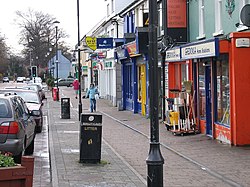Shankill, Dublin
|
Shankill Seanchill
|
|
|---|---|
| Suburb of Dublin | |

Shankill
|
|
| Location in Ireland | |
| Coordinates: 53°13′34″N 6°07′26″W / 53.226°N 6.124°WCoordinates: 53°13′34″N 6°07′26″W / 53.226°N 6.124°W | |
| Country | Ireland |
| Province | Leinster |
| County | Dún Laoghaire–Rathdown |
| Dáil Éireann | Dún Laoghaire |
| Area | |
| • Suburb of Dublin | 6.4 km2 (2.5 sq mi) |
| Elevation | 29 m (95 ft) |
| Population (2006) | |
| • Urban | 13,258 |
| Postal district(s) | County Dublin |
| Dialing code | 01, +353 1 |
| Irish Grid Reference | O249220 |
Shankill (Irish: Seanchill, meaning "Old Church") is a suburb of Dublin, Ireland, situated in the administrative area of Dún Laoghaire–Rathdown. Located in the south-east of County Dublin, close to the border with County Wicklow, it has a population of 13,258 (2006 census).
The name Shankill is believed to derive either from the Irish Sean-Chill, meaning Old Church, or Sean-Choill, meaning Old Wood.
Shankill features a number of antiquities, including ráths and cromlechs. Around 1230, there were forests that were cleared under the orders of the then owner of Shankill, Archbishop Luke. Courts for serious crimes in the style of assizes were conducted at Shankill during this period. To keep the native Gaelic Irish out, fortified gates protected parts of the townland.
The manor of Shankill was overrun by the native Irish and completely destroyed a century later. In response to these incursions, a large garrison was re-instated. The Irish were restrained from entering and the land was eventually re-let as grazing land.
The Lawless family features prominently in the history of Shankill. In 1408, family members took control of the seigniory of Shanganagh and, by 1480, several branches of the family were residents of Shankill.
Between 1400 and 1600, a number of fortified structures - whose remains can still be seen to this day - were built: Shankill Castle, Shanganagh Castle and a strong house known locally as Puck's Castle. The Walsh family comes to prominence in the 16th century, building several further defensive structures in Shankill.
From 1640 onwards, the native Irish were subdued in a series of confrontations, leading to greater agricultural use of the lands. Around this time, Shankill was absorbed into the parish of Rathmichael.
The Walshes quit the lands of Shankill primarily due to the Act of Commonwealth which redistributed landowners and tenancies. After this, the Lawless families regained possession for the third time of lands around Shankill. The last Lawless died in 1795, whereupon the lands became the possession of the third Sir William Domvile, resident of nearby Loughlinstown House. The Domvile family was granted the lands surrounding Loughlinstown under the Restoration.
...
Wikipedia

